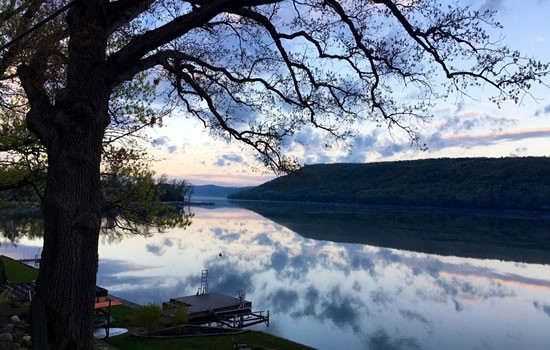― AQUATIC VEGETATION ―
How can I get rid of all these weeds by my dock?
Hold on, that might not be a such good idea! Aquatic plant communities provide critical fish and wildlife habitat. Native emergent plants are natural shoreline stabilizers because they reduce wave action that can erode shores, and act as filters to reduce nutrient runoff into the lake. Emergent plants also provide important cover, nesting and feeding areas for fish and wildlife. Plants such as eelgrass and broad-leaf pondweeds provide shade, shelter and foraging opportunities for fish. Fish also seek cover in beds of muskgrass (chara) and bushy pondweed. The taller, denser foliage of coontail and northern watermilfoil provide excellent habitat for aquatic invertebrates Eurasian milfoil is an exotic species that causes its own set of problems, however. In Keuka Lake Eurasian milfoil appears to be largely under control because of aquatic weevil and/or moth activity). Wild celery is one of the most important plants for waterfowl, which consume the stems, leaves and seeds of the plant. It is a favorite food of canvasback ducks. Seeds of all of the pondweeds are also eaten by waterfowl and the leaves may be grazed by muskrat, deer and beaver.
Therefore, any removal of these plants should be done in a manner that limits the disturbance to the overall plant community. A healthy diversity of native aquatic plants can also help prevent exotic species from becoming established in the lake. Removal of aquatic plants may require a permit from the New York State Department of Environmental Conservation (NYSDEC).
How can I get rid of all these weeds by my dock?
It's probably filamentous algae, sometimes called "moss" or "pond scum." This is a common and troublesome aquatic weed that forms dense, hair-like mats. This algae forms on near-shore bottom sediments or submerged objects in ponds and lakes where there is good transparency and where sunlight reaches the bottom of the pond or lake. As the algae grows, it produces oxygen that gets trapped in the entangled strands of algae. This entrapped oxygen makes the algae buoyant and causes it to rise to the surface of the pond or lake. Some of the more common forms of filamentous algae can be identified by their texture, although microscopic examination is usually required for exact recognition. Cladophora feels "cottony", while spirogyra is bright green and very slimy to the touch, and pithophora (or "horse hair") has a very coarse texture like horse hair or steel wool. The best method for homeowners to remove filamentous algae is to rake out the floating clumps and limit the nutrients that reach the water from your property. You can compost these piles or use them in your garden as mulch.
Source: Jim Balyszak, Peter Landre and the Minnesota Pollution Control Agency

